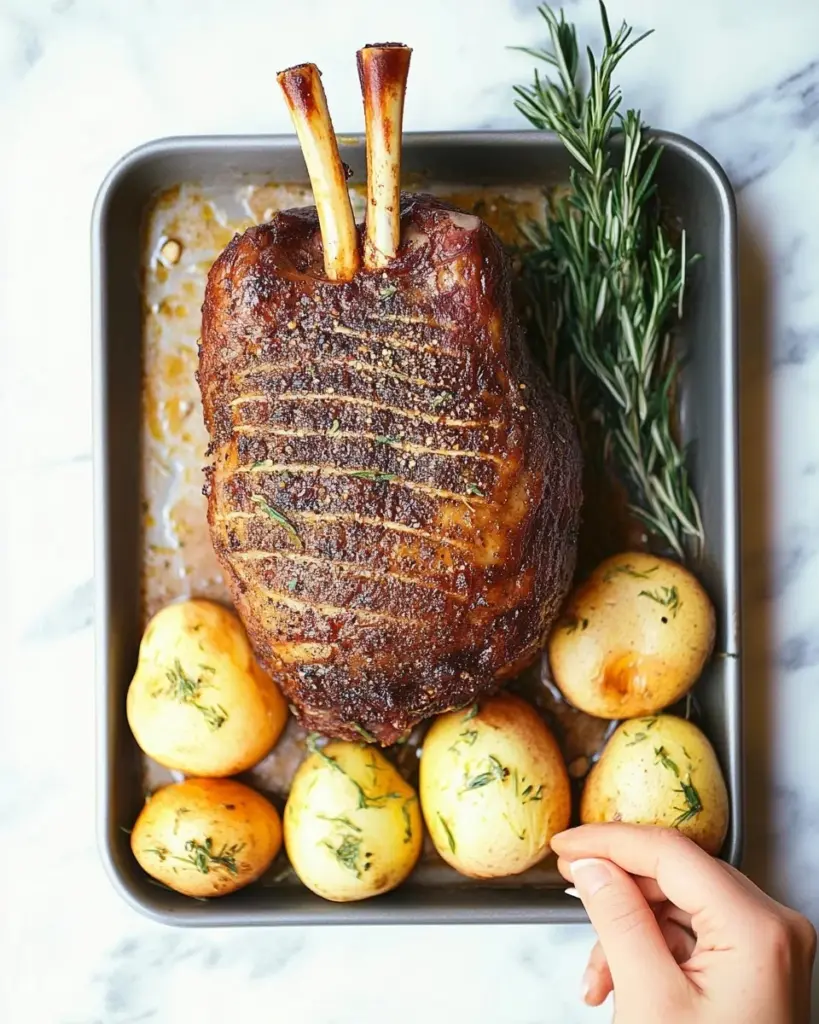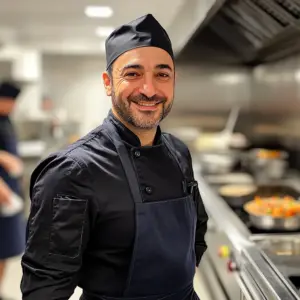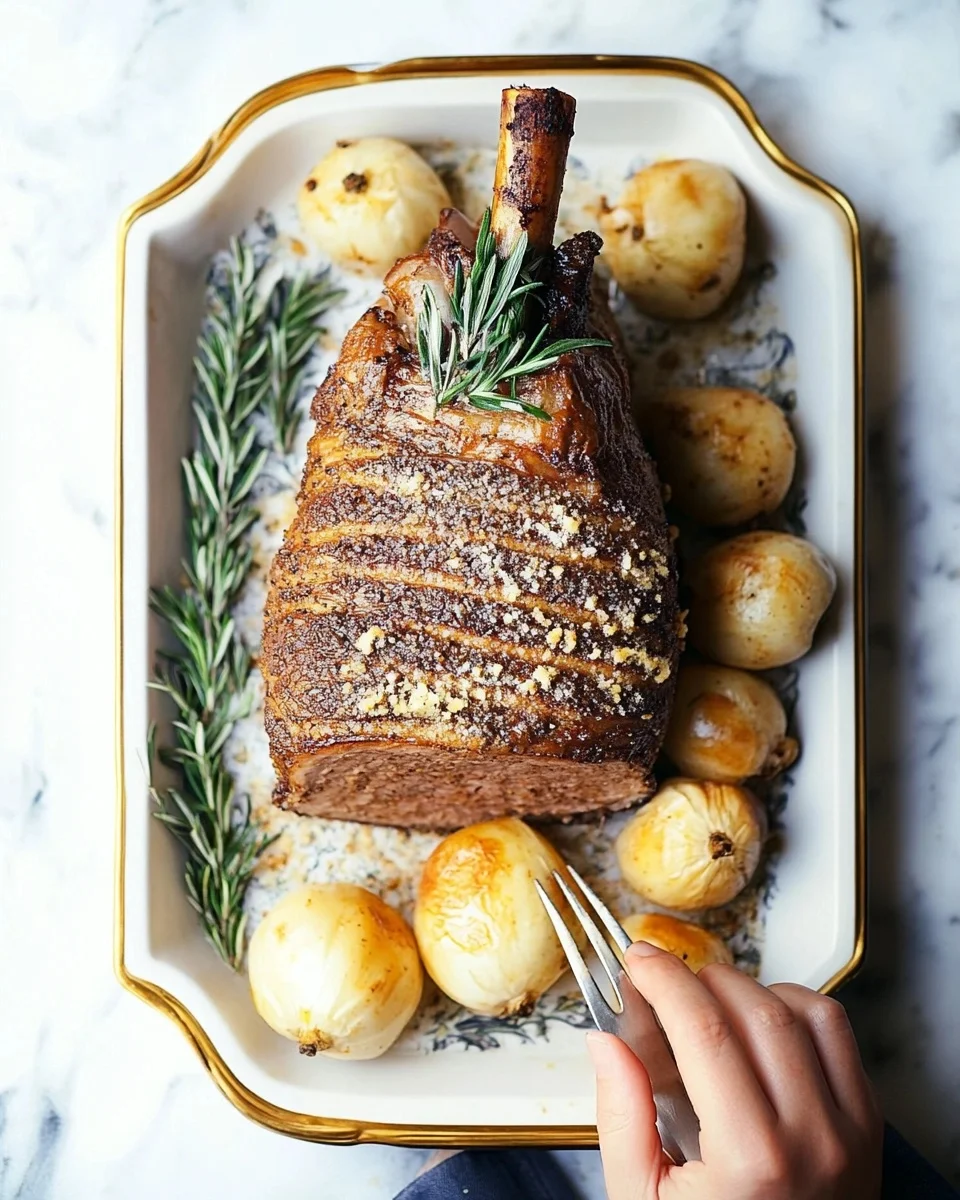A Family Tradition Passed Down Through Generations
There are certain dishes that transcend mere cooking and become part of a family’s history. In my home, roasted leg of lamb was one of those meals. It wasn’t an everyday dish, but a centerpiece reserved for special occasions—holidays, birthdays, and celebratory feasts where the entire family gathered around the table.
I still remember watching my grandmother prepare it. She never rushed the process, carefully massaging a fragrant blend of garlic, rosemary, and mustard into the lamb. As the meat roasted, the kitchen filled with an irresistible aroma—one that signaled warmth, love, and the promise of something extraordinary.
That first bite was always magical. The exterior had a crispy, herbaceous crust, while the inside remained tender and juicy. The combination of flavors—earthy rosemary, pungent garlic, the subtle tang of Dijon—was perfection. Every forkful carried with it the effort, patience, and care that went into the preparation.
Now, I carry on the tradition, making this dish for my own family. Whether it’s a quiet Sunday dinner or a festive gathering, this herb-crusted roasted leg of lamb never fails to impress. And today, I’m sharing this recipe with you, hoping it brings the same warmth and joy to your table.
Why This Recipe is a Showstopper
A perfectly roasted leg of lamb is one of the most impressive yet approachable dishes you can make. Despite its gourmet appeal, it requires minimal ingredients and straightforward preparation, making it an ideal choice for both experienced cooks and those new to roasting meats.
Here’s what makes this recipe special:
- Flavorful and Aromatic: The blend of garlic, rosemary, and thyme enhances the natural richness of the lamb, creating an irresistible crust.
- Juicy and Tender: Roasting at the right temperature ensures a succulent, evenly cooked interior.
- Impressive Yet Simple: While it looks elegant on the table, this dish requires only a few basic techniques.
Ingredients
- Main Ingredient:
- 1 (5-pound) bone-in leg of lamb, trimmed
- Flavorful Marinade:
- 4 cloves garlic, minced
- 1 tablespoon olive oil
- 1 tablespoon chopped fresh rosemary
- 1 tablespoon chopped fresh thyme leaves
- 1 tablespoon Dijon mustard
- 1 tablespoon kosher salt2 teaspoons ground black pepper
Directions
- Prepare the Oven:
- Preheat your oven to 350°F (175°C). Line a shallow roasting pan with aluminum foil for easy cleanup.
- Prepare the Lamb:
- Pat the leg of lamb dry with paper towels. Using a sharp knife, score the top side of the lamb in a diamond pattern, making shallow cuts to allow the marinade to penetrate.
- Make the Marinade:
- In a small bowl, combine the minced garlic, olive oil, chopped rosemary, chopped thyme, Dijon mustard, kosher salt, and ground black pepper. Mix until well combined.
- Marinate the Lamb:
- Place the lamb, fat side up, on a rack in the prepared roasting pan. Spread the garlic-herb mixture evenly over the lamb, rubbing it thoroughly into the scored cuts.
- Roast the Lamb:
- Place the roasting pan in the preheated oven. Roast until the internal temperature reaches 135°F (57°C) for medium doneness, about 1 hour 30 minutes to 1 hour 45 minutes. Use an instant-read thermometer to check the temperature.
- Rest and Serve:
- Remove the lamb from the oven and let it rest for 15 minutes before slicing. This allows the juices to redistribute throughout the meat. Slice and serve immediately, pairing it with mini hasselback potatoes or your favorite side dish.
Nutritional Information (Per Serving)
- Calories: Approximately 350 kcal
- Protein: 30g
- Fat: 24g
- Carbohydrates: 1g
- Fiber: 0g
- Sugar: 0g
- Sodium: 500mg

The Science Behind a Perfect Roasted Leg of Lamb
Understanding the Cut
The leg of lamb is one of the most flavorful cuts, offering a balance between lean meat and just enough fat to keep it juicy. It can be purchased bone-in or boneless, with the bone-in option providing extra depth of flavor.
- Bone-In: Offers better flavor and moisture retention, though it takes slightly longer to cook.
- Boneless: Cooks faster and is easier to slice, but may require extra tying to maintain its shape.
Why the Marinade Works
A well-balanced marinade doesn’t just add flavor; it also tenderizes the meat. Here’s why the key ingredients matter:
- Garlic: Infuses the lamb with deep, savory notes.
- Rosemary & Thyme: Provide an earthy aroma that complements the natural taste of lamb.
- Dijon Mustard: Adds a subtle tang that balances the richness of the meat.
- Salt & Pepper: Enhance the overall flavors, ensuring a well-seasoned roast.
Mastering the Art of Roasting
To achieve a perfectly cooked lamb roast, temperature control is crucial. Here’s a guide to internal temperatures for different levels of doneness:
- Rare: 125°F (52°C) – Deep pink, very juicy
- Medium-Rare: 135°F (57°C) – Pink, tender and juicy (recommended for lamb)
- Medium: 145°F (63°C) – Slightly firm, still juicy
- Well-Done: 160°F (71°C) – Firm, drier texture
For the best results, use a meat thermometer and remove the lamb from the oven about 5°F before your target temperature, as it will continue cooking while resting.
Perfect Pairings: What to Serve with Roasted Leg of Lamb
A dish as bold as herb-crusted lamb deserves equally flavorful side dishes. Here are some classic pairings:
1. Classic Sides
- Roasted Garlic Mashed Potatoes: Creamy, buttery, and the perfect companion to the lamb’s savory juices.
- Hasselback Potatoes: Crisp on the outside, soft on the inside—ideal for soaking up extra flavor.
- Honey-Glazed Carrots: Their natural sweetness complements the herbs and garlic.
2. Mediterranean-Inspired Accompaniments
- Greek Salad: A refreshing contrast with crisp cucumbers, tomatoes, feta, and olives.
- Tzatziki Sauce: A cool, garlicky yogurt-based sauce that enhances the lamb’s flavor.
- Lemon Roasted Asparagus: A light, zesty side dish that balances the richness of the meat.
3. Wine Pairings
- Red Wine: A bold Cabernet Sauvignon or Syrah pairs beautifully with the depth of lamb’s flavor.
- White Wine: If you prefer white, a full-bodied Chardonnay can complement the herbal notes.
FAQs: Answering Your Roasting Questions
1. How long should I marinate the lamb?
For the best flavor, marinate the lamb for at least 2 hours, though overnight is ideal. This allows the seasonings to deeply penetrate the meat.
2. Can I cook this in advance?
Yes! Roast the lamb ahead of time, then gently reheat it at 300°F (150°C) for about 10-15 minutes before serving.
3. What if I don’t have Dijon mustard?
You can substitute it with whole grain mustard or a blend of olive oil and lemon juice for a similar tangy effect.
4. Can I make this recipe with a boneless leg of lamb?
Absolutely. Adjust the cooking time slightly, as boneless roasts cook faster. Use kitchen twine to help maintain shape.
5. What should I do if my lamb is cooking too quickly?
If your roast is browning too fast, tent it loosely with foil to prevent excessive darkening while allowing the inside to cook through.
6. Why is resting the lamb important?
Resting for 15 minutes before slicing allows the juices to redistribute, ensuring a moist and flavorful bite.
A Flavorful Finale: Why This Recipe Belongs in Your Cookbook
The herb-crusted roasted leg of lamb is more than just a meal—it’s an experience. From the aromatic blend of rosemary and garlic to the succulent, perfectly roasted meat, this dish is designed to bring people together around the table.
Advertisement
It’s the kind of recipe that transforms an ordinary evening into a celebration, the kind that sparks conversations and memories, just as it has in my family for generations.
Whether you’re cooking for Easter, Christmas, a Sunday family dinner, or a special gathering, this dish never fails to impress. So take your time, savor the process, and most importantly—enjoy every bite.
After all, the best meals aren’t just about the food—they’re about the moments they create.






